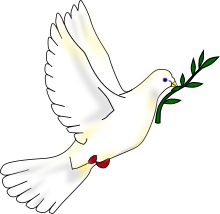Peace symbols

A peace symbol is a representation or object that has come to symbolize peace. The dove and the olive branch, or a dove carrying an olive branch in its beak, are ancient symbols of peace; in the latter part of the twentieth century, the peace sign, developed by the Campaign for Nuclear Disarmament, and the V hand signal came into use around the world.
The peace sign
The internationally recognized symbol for peace was originally designed for the British nuclear disarmament movement.[1] It was designed and completed on 21 February 1958 by Gerald Holtom, a professional designer and artist in Britain for the 4 April march planned by the Direct Action Committee Against Nuclear War (DAC) from Trafalgar Square, London to the Atomic Weapons Research Establishment at Aldermaston in England.[1][2] The symbol was later adopted by the Campaign for Nuclear Disarmament (CND). It was adopted by first the 1960s anti-war movement, then the counterculture, and finally the popular culture of the time.
The peace sign flag first became known in the United States in 1958 when Albert Bigelow, a pacifist protester, sailed his small boat outfitted with the CND banner into the vicinity of a nuclear test.[3]

The peace sign button was imported into the United States in 1960 by Philip Altbach, a freshman at the University of Chicago, who traveled to England to meet with British peace groups as a delegate from the Student Peace Union (SPU). Altbach purchased a bag of the "chickentrack" buttons while he was in England, and brought them back to Chicago, where he convinced SPU to reprint the button and adopt it as its symbol. Over the next four years, SPU reproduced and sold thousands of the buttons on college campuses. By the late 1960s, the peace sign had become an international symbol adopted by anti-war protestors of the Baby Boom Generation.[4]


The symbol itself is a combination of the semaphoric signals for the letters "N" and "D," standing for Nuclear Disarmament.[1] In semaphore the letter "N" is formed by a person holding two flags in an upside-down "V," and the letter "D" is formed by holding one flag pointed straight up and the other pointed straight down. Superimposing these two signs forms the shape of the centre of the peace symbol. In the first official CND version (which was preceded by a ceramic pin version that had straight lines, but was short lived) the spokes curved out to be wider at the edge of the circle, which was white on black.[1][5][6]
Holtom later wrote to Hugh Brock, editor of Peace News, explaining the genesis of his idea in greater depth: "I was in despair. Deep despair. I drew myself: the representative of an individual in despair, with hands palm outstretched outwards and downwards in the manner of Goya's peasant before the firing squad. I formalised the drawing into a line and put a circle round it."[6] Ken Kolsbum, a correspondent of Holtom's, says that the designer came to regret the symbolism of despair, as he felt that peace was something to be celebrated and wanted the symbol to be inverted.[7]
The original drawing by Gerald Holtom of the CND symbol is housed in the Peace Museum, U.K.[1] in Bradford, England.
In Unicode, the peace sign is U+262E: ☮, and can thus be generated in HTML by typing ☮ or ☮. However, internet browsers may not have a typeface that can display it.
The gravestone of Ed Bishop, actor and anti-war campaigner, has a peace symbol prominently engraved on it.
V-sign

The "V-sign", also called the "peace sign" and the "victory sign," is a hand gesture with the index and middle fingers open and all others closed. It was used as a sign for victory during the Second World War by Winston Churchill, originally with palm inwards; Churchill switched to palm outwards later in the war, possibly because [citation needed] the insulting meaning of the palm inwards version had been explained to him.
This developed into a peace sign during protests in the USA against the Vietnam War (and subsequent anti-war protests), and was adopted by the North American counterculture as a sign of peace. Because the hippies of the day often showed the sign while saying "Peace", it became known as the peace sign, the name still used today.[8]
Peace flag
The peace flag is a series of seven rainbow stripes with the word for peace printed in the center. The first such flags made were emblazoned with PACE (Peace in Italian and Romanian, derived from the Latin word pax, pronounced pah-chay). Previous Italian peace flags had featured a dove drawn by Pablo Picasso;[9] the new design first appeared in an Italian peace march as early as September 24, 1961, in an Italian peace march.
The flag is often flown from balconies in Italy by citizens opposed to the Iraq war.[10] Its use has spread to other countries as well, with the Italian "pace" replaced with its translation in various other languages.[10]
In recent years, especially in connection with the 2003 Invasion of Iraq, there has been a surge in popularity of the Peace flag.[10] According to Amnesty International, producer Franco Belsito had produced only about 1,000 flags annually for 18 years, and suddenly had to cope with a demand in the range of millions.[10]

Dove and olive branch
In Judaism and Christianity an olive branch is a sign for peace. The Torah (The Old Testament)describes a story in which a dove was released by Noah after the Great Flood in order to find land. The dove came back carrying an olive branch in its beak, proof for Noah that the Great Flood had receded. (Book of Genesis 8:11).
In Greek tradition, olive branches represent peace.[11] The plant was considered sacred to the ancient goddess of wisdom and defensive warfare, Athena.[11]
Defeated Roman armies displayed olive branches as a white flag to indicate surrender.[12][13]
The motif can also represent "hope for peace" and even a peace offering from one man to another, as in the phrase "extend an olive branch".[13]
Shalom and Salaam
The Hebrew word "Shalom" (Hebrew: Template:Hebrew), and the Arabic "Salaam" (Arabic: Template:Rtl-lang) have been used as peace symbols. Shalom and Salaam literally mean "peace" and are cognates of each other, derived from the Semitic triconsonantal of Ś-L-M (realized in Hebrew as Š-L-M and in Arabic as S-L-M).
The congruence of both words has come to represent "peace in the Middle East" and an end to the Arab-Israeli conflict. Its significance is such that wall plaques and signs are sold with only those words, and the words are featured in such Israeli peace songs such as "Salaam (Od Yavo Shalom Aleinu)", sung in both Hebrew and Arabic,[14] and "Shalom Salaam Peace" by HaMehona Shel HaGruv.[15]
-
A peace sign in Arabic, English and Hebrew
-
"Shalom" in blue "Salaam" in green "Peace" in orange

White Poppy
The White Poppy campaign began in 1932[16] by the Women's Co-operative Guild to distribute an alternative to the Red Poppies used to commemorate British military dead,[16] and the first poppies were distributed in 1933. The newly-formed Peace Pledge Union (PPU) joined in distributing them in 1934, and white poppy wreaths were laid "as a pledge to peace that war must not happen again". In 1980, the PPU revived the symbol as a form of remembering the victims of war without glorifying militarism.
The Broken Rifle

The Broken Rifle symbol associated with War Resisters' International and its affiliates actually predates the foundation of WRI in 1921.
The first known example of the Broken Rifle was in the mast-head of the January 1909 issue of De Wapens Neder (Down With Weapons), the monthly paper of the International Antimilitarist Union in the Netherlands. In 1915 it appeared on the cover of a pamphlet, Under det brukne Gevaer (Under the Broken Rifle), published by the Norwegian Social Democratic Youth Association. The (German) League for War Victims, founded in 1917, used the broken rifle on a 1919 banner. In 1921, Belgian workers marching through La Louvrière on 16 October 1921, carried flags showing a soldier breaking his rifle.
Ernst Friedrich, a German who had refused military service, founded the Anti-Kriegs Museum in Berlin with a bas-relief broken rifle over the door, and the Museum distributed broken rifle badges, girl's and women's brooches, boy's belt buckles, and men's tie pins.[17]
Personification
In Greek and Roman mythology, the goddesses Eirene or Irene, Pax and Tranquillitas personified tranquility, security, calmness, peace.

Other peace symbols
The crane is a traditional symbol in Japan for, among other things, peace. Paper cranes are often folded, especially around the time of the New Year; a thousand origami cranes is a symbol of good luck.
Some unique items have come to symbolize peace. For example, the Japanese Peace Bell was a gift from the UN Association of Japan to the United Nations, presented to them in 1954. The bell remains at UN headquarters and is struck yearly, in remembrance of peace.
The Pax Cultura symbol, created by Nicholas Roerich, has also been used as a peace symbol.
Date palms are signs of peace and plenty in Judaism.
See also
References
- ^ a b c d e f "Peace Symbol". The Peace Museum's Collection. The Peace Museum, Bradford."A symbol for the organisation was created by Gerald Holtom. His design represented the semaphore letters 'N' and 'D', standing for 'Nuclear Disarmament.' It was displayed at CND's first direct action, the Aldermaston march of Easter 1958. Not patented or restricted, the logo crossed national and cultural boundaries as a symbol of peace." - The Peace Museum, Bradford
- ^ "A Piece of Our Time". Time Magazine. Retrieved 2 April 2008.
- ^ Lawrence S Wittner. The Struggle Against the Bomb: Volume Two, Resisting the Bomb: A History of the World Nuclear Disarmament Movement. Stanford University Press. p. 55. Retrieved 24 July 09.
{{cite book}}: Check date values in:|accessdate=(help) - ^ Ken Kolsbun with Mike Sweeney. Peace: The Biography of a Symbol. National Geographic Books. ISBN 9781426202940. Retrieved 2008-08-28.
{{cite book}}: Unknown parameter|sate=ignored (help) - ^ "The CND symbol". Hugh Brock Papers.
- ^ a b "The CND logo". Campaign for Nuclear Disarmament. Retrieved 2008-04-03.
- ^ Westcott, Kathryn (2008-03-20). "World's best-known protest symbol turns 50". bbc.co.uk. Retrieved 2008-03-20.
{{cite news}}: Cite has empty unknown parameter:|coauthors=(help) - ^ The Japanese Version (the Sign of Peace). Accessed 23 July 09
- ^ "Bandiera della pace". Elettrosmog.
- ^ a b c d "Det nytter!" (in Norwegian). Amnesty International. 2003-06-06. Retrieved 2008-03-22.
- ^ a b "The olive tree in Crete and Greece". Explore Greece.
- ^ "Chapter 8: of Scipio Aemilianus Africanus - How he destroyed Carthage". Roman History. Kellscraft.
- ^ a b "What does it mean to "extend an olive branch"?". Wise Geek.
- ^ "Od Yavo Shalom Aleinu / Peace Will Come to Us". Hebrew Songs.
- ^ "HaDag Nachash - Shalom, Salaam, Peace (English Subtitled)".
- ^ a b "Margaret Llewelyn Davies (1861 - 1943) and Emmy Freundlich (1878 - 1948)". Women of Conviction. Hull Women's Archives.
- ^ Bill Hetheringon, Symbols of Peace, Housmans Peace Diary 2007, London: Housmans, 2006
External links
- Happy Birthday Peace - celebrating 50 years of Gerald Holtom's peace symbol
- The biography of the Peace Symbol by Ken Kolsbun - PeaceSymbol.com
- A tribute to the Peace Symbol and the Peace Sign - PeaceSymbol.org
- Peace Symbols - Free clip art
- Peace symbols Part I - peace signs and images (author: Arash Vahdati)
- Peace symbols Part II - peace signs and images (author: Karan Reshad)
- What is the origin of the peace symbol? (from The Straight Dope)
- Teach Peace - Teach Peace Moment: Peace Symbol History
- World's best-known protest symbol turns 50 - BBC News


